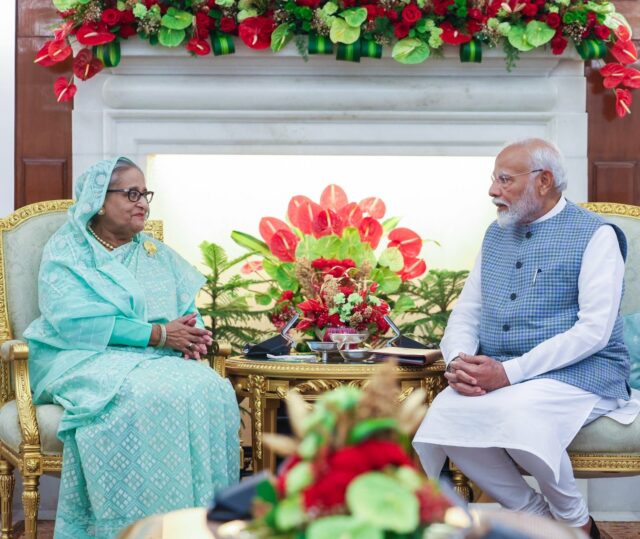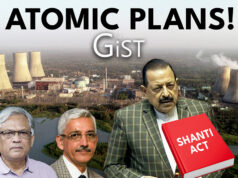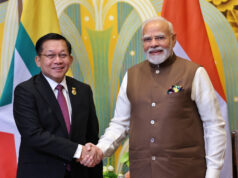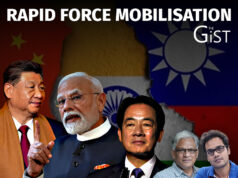Bangladesh Prime Minister Sheikh Hasina wrapped up her two day State visit to India on Saturday with an agreement to commence negotiations on a Comprehensive Economic Partnership Agreement (CEPA), and unveiled a shared vision document for prosperity.
This is the first incoming State visit in Prime Minister Narendra Modi’s new term.
The two sides released a 14 point Shared Vision for Future aimed at enhancing connectivity, commerce and collaboration for shared prosperity. The joint statement articulates the resolve of leaders of India and Bangladesh to work towards early negotiations for CEPA, early operationalisation of two Special Economic Zones (SEZs) , opening of new border haats, trade facilitation and improvement of road, rail and maritime connectivity.
The two sides have also decided to co lead the ‘Disaster Risk Reduction and Management’ pillar at the Indo Pacific Oceans Initiative.
In a statement following discussions with his Bangladeshi counterpart, Prime Minister Narendra Modi said that Bangladesh is India’s largest development partner and New Delhi attaches the highest priority to its relations with that country.
He said that the two nations have developed a futuristic vision for cooperation in new sectors and agreements on green partnership, digital partnership, blue economy, and space will benefit the youths of both countries.
But the most welcome development for Dhaka is India’s offer of an e-medical visa facility for Bangladeshi nationals coming to India for medical treatment.
The two sides exchanged ten agreements including two vision documents on India Bangladesh Digital Partnership and India Bangladesh Green Partnership. Equally important are the MoUs on maritime cooperation and blue economy and between In-Space and Bangladesh’s Ministry of ICT and Telecom.
Other MoUs include railway connectivity, cooperation in Oceanography, and cooperation in military education on strategic and operational studies.
The domains in which MoUs have been renewed include health and medicine, disaster management, resilience and mitigation and cooperation in fisheries.
The decision to grant medical e-visa is significant given the fact that India is a big medical destination for Bangladeshi nationals. Sources said nearly 4.5 lakh medical visa applications were made by Bangladeshi nationals in 2023 alone. That averages out to more than 1,200 medical visa applications every single day.
Both sides also agreed to open a new Indian Assistant High Commission in Rangpur to facilitate visa and consular services.
The other key announcements include the visit of a technical delegation to Bangladesh conservation and management of the Teesta river, a new train service between Rajshahi and Kolkata and a new bus service between Chittagong and Kolkata.
The close ties between the two nations can be gauged by the fact that Prime Minister Sheikh Hasina was in New Delhi only a fortnight ago as a guest at Prime Minister Modi’s swearing in ceremony.
Acknowledging these close ties, Modi said, “In the last one year, we have met 10 times, but today’s meeting is special because PM Hasina is the first state guest of our third government. Bangladesh is crucial for our Neighbourhood First policy, Act East Policy, Vision SAGAR, and Indo-Pacific vision. We have completed several developmental programmes together in the last year.’’
Prime Minister Narendra Modi also wished the Indian and Bangladeshi ahead of the T20 World Cup Super 8 clash between India and Bangladesh today.
He also said that the two countries have have started trading in Indian Rupees, and highlighted the export of power from Nepal to Bangladesh using the Indian grid.
Stressing on ‘Connectivity, Commerce, Collaboration’, he said the two sides are ready to initiate talks on CEPA, and that the Bharat-Bangladesh Maitri Satellite will take India-Bangladesh relationship to new height.
At a special briefing on the visit earlier, Foreign Secretary Vinay Mohan Kwatra said that the India Bangladesh shared vision document for futuristic partnership seeks to realize the respective national development visions of Viksit Bharat 2047 and Smart Bangladesh Vision of 2041.
Talking of the MoU on space cooperation, Kwatra said it seeks to establish collaboration between the two sides for launch of a jointly developed small satellite for Bangladesh on India’s launch vehicle.
As for the medical e-visas, he said: “ I don’t have precise numbers on the number of people who actually would be utilising this particular service but it is our understanding that there is a substantial chunk of current visa applicants from Bangladesh that prefer to come to India for medical treatment. The numbers could range anywhere between 20 to 30 per cent of the total number of applications received by our embassy in Dhaka. It is a fairly large number of people. More importantly, it is also a segment of people we want to prioritise in terms of focus mainly because it pertains to their medical needs. As soon as the processes are put in place to start implementing the platform for utilization of these e visas, they would be available to the applicants.’’
The two leaders discussed The Bay of Bengal Initiative for Multi-Sectoral Technical and Economic Cooperation (BIMSTEC) as a means of of strengthening regional and sub regional engagement. The Rohingya issue too was brought up during the discussion, he added
Earlier this morning, Sheikh Hasina was accorded a ceremonial reception at the Rashtrapati Bhavan. It was followed by a visit to Rajghat to pay respects to Mahatma Gandhi.
Addressing the media after her talks with PM Modi in restricted and delegation level formats, Sheikh described India as a major neighbour, trusted friend, and crucial regional partner, and underlined the enduring bond that originated during Bangladesh’s War of Liberation in 1971.
Before flying back to Dhaka, the Bangladesh Prime Minister paid courtesy calls on the Vice President and President of India.
Delhi based journalist pickled in journalism. Have reported from nine world capitals and almost all parts of India. Over the last three decades, I have worked for India’s mainstream English dailies and contributed to All India Radio, Doordarshan and Women’s Feature Service. Also worked for international media including Japan’s leading newspaper, The Asahi Shimbun and done assignments for The Sunday Times, London, The Telegraph, The Guardian and the Canadian Broadcasting Corporation. Worked in the Embassy of France in New Delhi and can speak French to save my life. Write on Diplomacy, Politics and the social sector. Love Nature, heritage, Nature, animals and vintage cars. Enjoy cycling and playing badminton.





